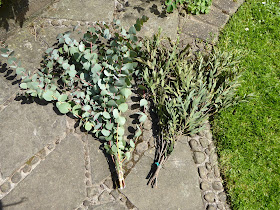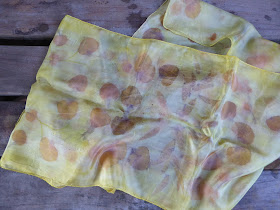Last month, my companion, Elinor Gotland, decided I had better take up the challenge and unbox the beast.
"Seriously, Beaut, all this good silk is wasted sitting in a bag. Get that machine out, how hard can it be?"
Half an hour later and I was frowning over the manual again.
"What's up now?"
"The bobbin's run out and I need to learn how to refill it."
Elinor came over to look at the diagrams.
"Fair play, your Mum did all the practice exercises in the instruction book, see how neatly she's filed her sewing samples. Very organised, bet that's a big help to you now."
"No it is not, it just makes me feel even more inadequate. I can't work out how to make this clever machine do simple stuff on easy fabric, let alone hem silk scarves with the special roller foot."
"To be honest, Beaut, you have mangled that cotton." She stroked the waiting silk. "In this life, some of us have finesse, others are better suited to a hard hat and steel toe caps."
"You're right. This is awful. I shall give up dyeing silk scarves." I headed out to walk the dog, leaving Elinor aghast. That sheep has a passion for silk, she is my biggest customer, though she's never paid for a scarf yet.
I came home to find a nice cup of tea and a biscuit waiting for me.
"Have you thought of buying ready hemmed silk scarves, at all, Beaut?"
"Well, I've seen them advertised quite cheaply online, only, remember that time I bought 10 metres of bargain silk jersey noil and spent days trying to wash the horrible sericin smell out of it? It's too dodgy to buy silk without handling it first."
"What if I could recommend a really well reviewed online retailer?"
"Like who?"
"Dharma Trading."
"I've heard of them, but they're in the USA. How daft is it to pay shipping and duty buying silk from America, when really, silk comes from China?"
"Perhaps you'd prefer to buy yourself a camel and set off down the Silk Road?"
Resistance was useless. Elinor guided me on a virtual tour of the Dharma website, revelling in all the choices of blank silk scarf sizes and types.
"OMG, they've got silk charmeuse, absolute heaven."
"I don't know what charmeuse is, but I can see it costs twice as much as Habotai."
Elinor sniffed weakness and plunged in.
"You love Habotai, you know it's good, these hemmed scarves aren't expensive, be a devil, click the button, buy a dozen."
"Habotai is good quality silk, I'll grant you, but Dharma don't say if theirs is light, medium or heavy weight. The scarf sizes are given in inches, then suddenly they seem to have gone metric - who knows what 8mm means?"
"Momme."
"Mum knows? Small problem there."
"Eight momme. It's an imperial measure. 8mm means that 100 yards of the silk fabric weighs 8 pounds. I like to have frocks made in 8mm silk, call it medium weight, no-one can see your knickers through it."
"Alright, I'll get a few of those."
"You'll need several sizes."
I bought five of two sizes of Habotai scarves and inevitably, ended up with some more in crepe de chine, silk satin and even two in silk charmeuse. The whole lot cost me £160 and another £31 in duty, though it was no more trouble than buying within the UK. My package arrived within the week and the courier took the duty payment at the front door. Totting up the cost including postage, habotai cost about £8 per scarf and the silk satin and silk charmeuse scarves were nearer £15 each.
Pulling them out of their bags, the quality of the scarf fabrics felt lovely and the hemming was faultless. They all survived scouring in the washing machine 30 degree wool cycle and cold mordanting in 10% alum by weight, without ill effect. Just as the dye garden came into full bloom in the heat wave, the scarves were ready to dye. If you would like to know the details of my method of using fresh dye plants for contact printing, have a look at this blog from last summer. In brief, I laid one wet scarf on a strip of baking parchment, arranged plants such as coreopsis tinctoria, weld, Dyers Chamomile and madder roots on top of it, then laid another wet scarf on top, sandwiching the plants, before rolling all the layers round a section of plastic drainpipe.
After tying them up with string, the rolls were simmered for an hour or so, left to cool in the pot overnight and dried out for several days before unrolling. Then they had a few more days to cure, a rinse in the sink and a wash in the machine wool cycle with a pH neutral detergent and a hot steam iron.
It's jolly difficult to take a photo that really shows up the differences, but here is a shot of a crepe de chine scarf on the left that was sandwiched together with the habotai scarf on the right. Crepe de chine has a matte surface and a granular texture, whereas habotai is fine, smooth and shining. I prefer the feel of habotai, though I was delighted with how crisply the prints had come out on the crepe. In real life, it is easier to see that the fine detail of the same plants shows better on the crepe de chine.
Here are another matching pair of habotai above and silk satin below. I think both scarves have printed equally well, but now I have seen and felt the silk satin, I know why you would pay twice as much, the finished scarf just looks better. One surface has a furry lustre almost like moleskin, a greater weight and sheen than habotai, it is rich and soft to handle, rather than slippery. Apparently, this is down to the particular weaving technique that makes satin.
Finally, charmeuse on the left versus habotai on the right. Oh, the charmeuse. I read that it has a lightweight satin weave, but the stuff Dharma sells looks and feels heavier than their silk satin and seems even more luxurious to me. Plus I think it has taken the plant prints as well as the crepe de chine did.
Here are some more from the next batch, dyed in a bath of silver birch bark to colour the edges pink. Charmeuse at the top, crepe in the middle and habotai at the bottom.
"Pleased with your online shopping, are you, Beaut?"
"Very much so, thanks Elinor. You'd better pick your favourite scarf now, I'll be selling them all at The Big Cheese Festival in Caerphilly tomorrow."
"Maybe not. The hot weather is due to break tonight and we're forecast thunderstorms and downpours all weekend."
"Hey ho, maybe the visitors will take shelter in the Craft Marquee."






































